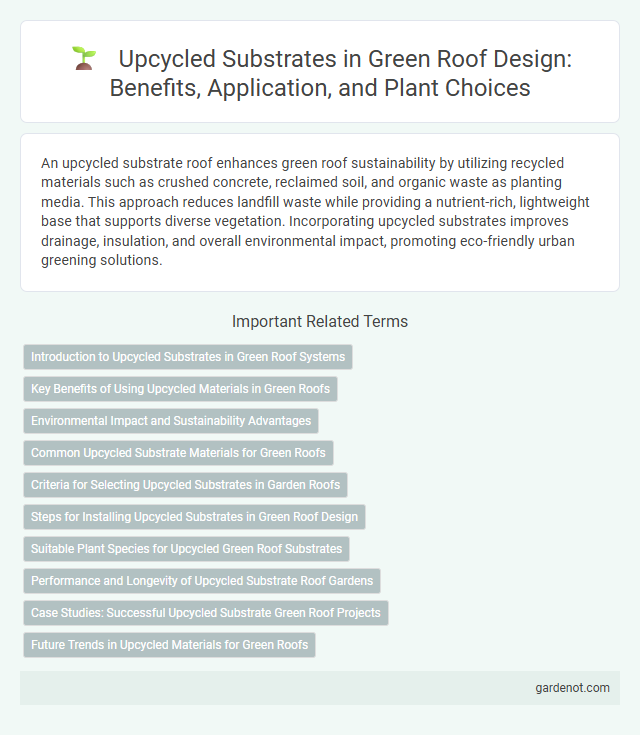An upcycled substrate roof enhances green roof sustainability by utilizing recycled materials such as crushed concrete, reclaimed soil, and organic waste as planting media. This approach reduces landfill waste while providing a nutrient-rich, lightweight base that supports diverse vegetation. Incorporating upcycled substrates improves drainage, insulation, and overall environmental impact, promoting eco-friendly urban greening solutions.
Introduction to Upcycled Substrates in Green Roof Systems
Upcycled substrates in green roof systems utilize reclaimed materials such as crushed bricks, recycled concrete, and organic waste to create an eco-friendly growing medium that reduces landfill waste and lowers the carbon footprint. These substrates improve drainage, aeration, and water retention while supporting plant growth comparable to traditional soil mixes. Implementing upcycled substrates contributes to sustainable urban development by promoting circular economy practices and enhancing the environmental performance of green roofs.
Key Benefits of Using Upcycled Materials in Green Roofs
Using upcycled substrate materials in green roofs significantly reduces landfill waste and lowers the demand for virgin resources, promoting environmental sustainability. These substrates improve soil structure and moisture retention, enhancing plant health and overall roof longevity. Cost efficiency is boosted by utilizing readily available recycled materials, making green roof installation and maintenance more affordable.
Environmental Impact and Sustainability Advantages
Upcycled substrate roofs significantly reduce landfill waste by repurposing materials like crushed concrete, reclaimed soil, and organic compost as growing media, thereby lowering the demand for virgin resources. This sustainable practice minimizes carbon emissions associated with raw material extraction and transport, promoting a circular economy within the green roofing industry. Enhanced stormwater management and improved thermal insulation further contribute to urban heat island mitigation and biodiversity support, underlining the environmental benefits of upcycled substrates.
Common Upcycled Substrate Materials for Green Roofs
Common upcycled substrate materials for green roofs include recycled concrete, crushed brick, and reclaimed wood chips, which provide sustainable alternatives to traditional soil. These materials enhance drainage, reduce weight, and improve root aeration while minimizing environmental impact through waste repurposing. Incorporating upcycled substrates contributes to greener urban infrastructure by promoting resource efficiency and reducing landfill waste.
Criteria for Selecting Upcycled Substrates in Garden Roofs
Selecting upcycled substrates for green roofs requires evaluating permeability, nutrient content, and structural stability to support healthy plant growth and long-term durability. Materials like crushed concrete, expanded clay, and recycled organic compost are favored for their ability to retain moisture while ensuring proper drainage. Prioritizing substrates that minimize environmental impact and enhance insulation properties contributes to sustainable and efficient garden roof systems.
Steps for Installing Upcycled Substrates in Green Roof Design
Upcycled substrate installation in green roof design begins with selecting eco-friendly materials such as crushed brick, recycled glass, and composted organic waste to create a nutrient-rich growing medium. The process involves layering drainage mats, waterproof membranes, and then evenly distributing the upcycled substrate to ensure optimal water retention and root support. Final steps include planting native vegetation suited for local climate conditions and regular maintenance to monitor substrate health and prevent compaction.
Suitable Plant Species for Upcycled Green Roof Substrates
Suitable plant species for upcycled substrate green roofs include drought-tolerant succulents like Sedum, native grasses such as Festuca ovina, and hardy perennials including Allium and Achillea. These plants thrive in lightweight, nutrient-variable substrates derived from recycled materials, ensuring durability and low maintenance. Selection prioritizes species with shallow root systems and high resilience to temperature extremes and limited moisture availability.
Performance and Longevity of Upcycled Substrate Roof Gardens
Upcycled substrate roof gardens demonstrate enhanced performance through improved water retention and nutrient recycling, reducing the need for supplemental irrigation and fertilizers. The dense matrix of recycled materials fosters robust plant growth and resilience against environmental stressors, extending the system's longevity. Studies indicate that these sustainable substrates maintain structural integrity and soil health over multiple growing seasons, outperforming traditional soil mixtures in durability and ecological benefits.
Case Studies: Successful Upcycled Substrate Green Roof Projects
Case studies of successful upcycled substrate green roof projects showcase improved sustainability by reusing construction waste and organic material as growing mediums. Notable examples include the New York City Green Infrastructure Program, which reduced stormwater runoff by 30% using crushed concrete and compost substrates. These projects demonstrate enhanced plant growth, cost savings, and positive environmental impact in urban settings.
Future Trends in Upcycled Materials for Green Roofs
Future trends in upcycled materials for green roofs emphasize enhanced sustainability through the integration of recycled construction waste, such as crushed concrete and repurposed glass, which improve drainage and structural stability while reducing landfill impact. Innovations in bio-based composites derived from agricultural byproducts like coconut coir and rice husk are gaining traction for their lightweight, nutrient-rich properties beneficial to plant growth. Advanced treatments to increase pollutant filtration capabilities and microbial resilience are expected to further optimize upcycled substrates for urban heat island mitigation and stormwater management.
Upcycled substrate roof Infographic

 gardenot.com
gardenot.com